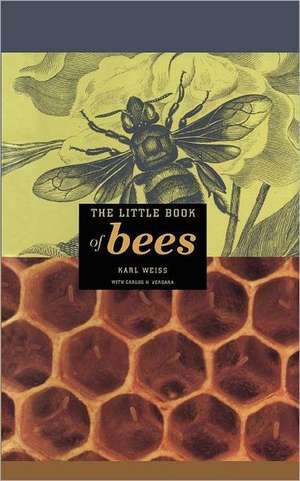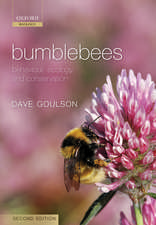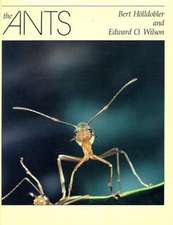The Little Book of bees: Little Book Series
C.H. Vergara Autor Karl Weissen Limba Engleză Paperback – 14 dec 2011
| Toate formatele și edițiile | Preț | Express |
|---|---|---|
| Paperback (1) | 127.22 lei 3-5 săpt. | |
| Springer – 14 dec 2011 | 127.22 lei 3-5 săpt. | |
| Hardback (1) | 156.48 lei 3-5 săpt. | |
| Springer – 23 sep 2002 | 156.48 lei 3-5 săpt. |
Preț: 127.22 lei
Nou
Puncte Express: 191
Preț estimativ în valută:
24.35€ • 25.32$ • 20.10£
24.35€ • 25.32$ • 20.10£
Carte disponibilă
Livrare economică 25 martie-08 aprilie
Preluare comenzi: 021 569.72.76
Specificații
ISBN-13: 9781441929228
ISBN-10: 1441929223
Pagini: 172
Ilustrații: VIII, 163 p. 21 illus.
Dimensiuni: 127 x 203 x 9 mm
Greutate: 0.19 kg
Ediția:2002
Editura: Springer
Colecția Copernicus
Seria Little Book Series
Locul publicării:New York, NY, United States
ISBN-10: 1441929223
Pagini: 172
Ilustrații: VIII, 163 p. 21 illus.
Dimensiuni: 127 x 203 x 9 mm
Greutate: 0.19 kg
Ediția:2002
Editura: Springer
Colecția Copernicus
Seria Little Book Series
Locul publicării:New York, NY, United States
Public țintă
Popular/generalCuprins
Bees in the Animal Kingdom and in Earth’s History.- The Bee—An Insect.- What Does “Social” Mean in the Animal Kindgom?.- The Traits of Bees and Their System.- Solitary Bees and Social Development.- Bumblebees and Stingless Bees.- On the Summit of Social Insect Life.- Nest Aids for Wild Bees.
Recenzii
From the reviews:
"The authors Karl Weiss and Carlos H. Vergara give a startling view into the surprisingly complex and highly organized world of bees. The book describes not only the evolution of our honeybee, but also of dozens of types of wild bees. It sheds light on bee society, with its amazing rituals related to work, reproduction, defense of the hive, and, most amazingly, communication, and it even provides helpful advice for those interested in helping bees nest." (Science in Africa, November, 2002)
"This book introduces bees in a nontechnical style understandable to general readers. This reviewer found it enjoyable and learned many interesting facts. … Recommended to anyone who wants to learn more about bees … ." (R. C. Graves, Choice, February, 2003)
"This charming introduction, written for a general audience, is primarily devoted to describing the various kinds of bees, their history and role in the ecosystem, and their private and social lives. Entomologists Weiss and Vergara are engagingly enthusiastic about their topic. Presented in a charming small format … ." (SciTech Book News, December, 2002)
"Great things to do, indeed, sometimes come in small packages, and The Little Book of Bees provides the proof. Packed into a tightly written book of 150 small pages is a goldmine of information about bees. … At all times, the book is intelligently written, easily read by the layman while also offering serious bits of science to those who want to know more. Any reader can learn a lot from this book." (Epinions.com, January, 2003)
"A beautifully presented book. It provides a thoughtful, precise and readable text that will be appreciated by anyone wanting to lean more about the many different kinds of bees, of which the best known honeybees and bumblebees are but a tiny minority. … Illustrated with excellent line drawings." (Beekeeping & Development, Issue 66, March, 2003)
"I opened thebook with some trepidation, but found that I had entered a treasure trove of information about species of bees, both known and entirely unknown to me – and I rapidly became absorbed in its content! … The social development of many of the solitary bees is effectively described, together with their unique mating behaviour, whilst defence strategies are carefully considered for the location and materials used in the building of brood nests against threats posed … . This is an excellent ‘little book’." (Beekeeping, February, 2003)
"Weiss is a great admirer of the sophisticated structures built by bees and tries to share his enthusiasm with a broader audience in this dainty, unassuming book co-written with Carlos Vergara. He charts the development of their social systems from the various primitive groups of solitary bees, through the beginnings of cooperative systems in the stingless and bumble bees to the pinnacle of achievement in the honey bee Apis mellifera, whose colonies may contain up to 80,000 individuals." (New Scientist, November, 2002)
"The authors Karl Weiss and Carlos H. Vergara give a startling view into the surprisingly complex and highly organized world of bees. The book describes not only the evolution of our honeybee, but also of dozens of types of wild bees. It sheds light on bee society, with its amazing rituals related to work, reproduction, defense of the hive, and, most amazingly, communication, and it even provides helpful advice for those interested in helping bees nest." (Science in Africa, November, 2002)
"This book introduces bees in a nontechnical style understandable to general readers. This reviewer found it enjoyable and learned many interesting facts. … Recommended to anyone who wants to learn more about bees … ." (R. C. Graves, Choice, February, 2003)
"This charming introduction, written for a general audience, is primarily devoted to describing the various kinds of bees, their history and role in the ecosystem, and their private and social lives. Entomologists Weiss and Vergara are engagingly enthusiastic about their topic. Presented in a charming small format … ." (SciTech Book News, December, 2002)
"Great things to do, indeed, sometimes come in small packages, and The Little Book of Bees provides the proof. Packed into a tightly written book of 150 small pages is a goldmine of information about bees. … At all times, the book is intelligently written, easily read by the layman while also offering serious bits of science to those who want to know more. Any reader can learn a lot from this book." (Epinions.com, January, 2003)
"A beautifully presented book. It provides a thoughtful, precise and readable text that will be appreciated by anyone wanting to lean more about the many different kinds of bees, of which the best known honeybees and bumblebees are but a tiny minority. … Illustrated with excellent line drawings." (Beekeeping & Development, Issue 66, March, 2003)
"I opened thebook with some trepidation, but found that I had entered a treasure trove of information about species of bees, both known and entirely unknown to me – and I rapidly became absorbed in its content! … The social development of many of the solitary bees is effectively described, together with their unique mating behaviour, whilst defence strategies are carefully considered for the location and materials used in the building of brood nests against threats posed … . This is an excellent ‘little book’." (Beekeeping, February, 2003)
"Weiss is a great admirer of the sophisticated structures built by bees and tries to share his enthusiasm with a broader audience in this dainty, unassuming book co-written with Carlos Vergara. He charts the development of their social systems from the various primitive groups of solitary bees, through the beginnings of cooperative systems in the stingless and bumble bees to the pinnacle of achievement in the honey bee Apis mellifera, whose colonies may contain up to 80,000 individuals." (New Scientist, November, 2002)


















